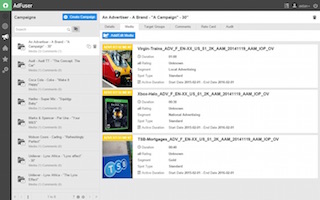 Rich Phillips is chief technology officer for Arts Alliance Media, one of the pioneers of digital cinema. In this, the first article in an ongoing series of articles about the cloud, Phillips and I talk about how the evolving technology is changing the cinema business including distribution and exhibition.
Rich Phillips is chief technology officer for Arts Alliance Media, one of the pioneers of digital cinema. In this, the first article in an ongoing series of articles about the cloud, Phillips and I talk about how the evolving technology is changing the cinema business including distribution and exhibition.
As CTO Phillips leads AAM’s technical strategy and is responsible for working out how the company provides products to its customers. He is an unabashed supporter of cloud technology and its potential in distribution and exhibition.
“One challenge with working with physical media instead of the cloud is what medium do you put it on,” he said. Adding to that, Phillips said, are the hardware costs and the costs of finding and maintaining the space for physical hardware and software.
Phillips has been with AAM from the beginning. When the company was founded in 2002, they quickly found that relying on physical hardware and software often meant under provisioning or over provisioning products, which proved to be expensive. Early on, Phillips saw cloud technology as an obvious solution to that problem.
“We offer software as a product and a service,” he explained, noting that, although some technology still has to reside in a customer’s facility – TMS servers, for example – a growing number of capabilities can now be moved to the cloud. One key benefit is that the cloud is pay as you go and offers the ability for quickly managing disaster recovery as well as creating fully synchronized copies.
“[Cloud providers] take care of all of that. It’s pretty cost effective, too,” said Phillips. AAM currently works with Amazon and is happy with their service. In the early days of cloud technology, the focus was on storage and virtual computers. The first industries to embrace cloud technology were retailers and telecom.
Cloud technology has evolved into managed services and Phillips said exhibitors are beginning to understand the benefits. “Cinemas are beginning to hire CTOs from retail and telecom for their cloud expertise,” he said. “In cinema it’s really changing.”
 Phillips said one of AAM’s biggest customers, the Odeon chain, told him that they now receive fifteen calls each month with people offering to sell them new software-based ideas. Cloud technology is helping to fuel these new ideas, he said, adding, “This technology allows us to be much more flexible.”
Phillips said one of AAM’s biggest customers, the Odeon chain, told him that they now receive fifteen calls each month with people offering to sell them new software-based ideas. Cloud technology is helping to fuel these new ideas, he said, adding, “This technology allows us to be much more flexible.”
Here is rest of our conversation:
Digital Cinema Report: What is Arts Alliance Medias role in exhibition?
Rich Phillips: Although also involved in other areas such as VPF financing and support, AAM’s primary focus in recent years has been as a specialist cinema software provider. Screenwriter, our theatre management solution, is the world’s most widely deployed TMS, and is complemented by a full suite of software tools covering circuit management, monitoring & support, advertising optimization and content delivery, with other products in development aimed at helping cinemas to exploit the full potential of the digital transition.
DCR: What is your personal involvement with cloud technology?
RP: Part of my role is to ensure that we have robust platforms on which we can host our software and offer it to customers through a SaaS (Software as a Service) model. In the past we managed this the traditional way – by purchasing hardware, installing it in data centres, and managing all aspects of provisioning ourselves, or by helping customers to implement our software within their own estates. More recently we have been moving towards true cloud hosting of our platforms through Amazon Web Services.
DCR: How, if at all, is cloud technology used at your company?
 RP: We now use cloud technology extensively to host our enterprise cinema software. Our Producer enterprise circuit management system, Locksmith KDM management system, Lifeguard NOC tools and AdFuser advertising campaign management system are all provisioned in AWS, with multiple points of presence in North America, Europe and Asia. As we move forward to focus on new innovative software and services to help our customers generate more revenue, we are firmly committed to offering them through the cloud.
RP: We now use cloud technology extensively to host our enterprise cinema software. Our Producer enterprise circuit management system, Locksmith KDM management system, Lifeguard NOC tools and AdFuser advertising campaign management system are all provisioned in AWS, with multiple points of presence in North America, Europe and Asia. As we move forward to focus on new innovative software and services to help our customers generate more revenue, we are firmly committed to offering them through the cloud.
DCR: Has cloud technology streamlined your operations or solved particular problems?
RP: It has been transformational, allowing us to reach out globally without the complexity of setting up multiple physical presences. Managing service resilience is much easier too – we have architected systems to cope with failure of any component or even a whole data centre. This sort of business continuity is complex and expensive to architect in house, but simple using the tools available from cloud service providers like Amazon. In addition, by embracing the value add services offered by the cloud providers, such as managed databases, we can focus our efforts on innovating the products and services. The flexibility is awesome. We can even spin up services on demand – automatically provisioning new servers when the load is high and closing them down again when the load subsides.
It has also brought huge benefits to our customers. By providing our software through the SaaS model, they are relieved of the complexity of trying to build and manage their own hosting systems, which can require specialist skills, which not all exhibitors have. Implementation and support are significantly simplified. They can benefit from the high performance and reliability of the cloud based platform and rest safely in the knowledge that it is being managed by experts. They are also relieved of any responsibility to patch or upgrade systems. It is all taken care of.
Support response is also improved, since there is no need to arrange remote access to customers systems to diagnose an issue, and management of the system is within our control.
DCR: Who owns the servers that host your cloud-based work?
RP: We use Amazon Web Services (AWS) to provide our cloud services. Along with Google and Microsoft, AWS are one of the leading cloud infrastructure providers. AWS power many well- known Internet services including Netflix, Airbnb and Dropbox.
 DCR: What advice have you given your company (or customers) regarding using cloud technology?
DCR: What advice have you given your company (or customers) regarding using cloud technology?
RP: The cloud is still relatively new for business-to-business applications, though that is changing – Salesforce is a great example of a successful cloud based B2B product. Two years ago there was more resistance – customers were anxious about service reliability and security, and were accustomed to running their own applications in house on their own systems. But attitudes are changing. The truth is that by building in the cloud we can make services much more resilient and secure than would be cost effectively possible otherwise, by employing the toolsets provided by the cloud providers and their partners, and benefiting from their considerable expertise and experience. Once customers understand the benefits they see that cloud hosting makes sense for them – that it will increase reliability and reduce costs.
DCR: Understanding that no technology is absolutely secure, and that to-date, cloud technology has a very strong track record as far as security is concerned, how does your company handle backing up and saving media and/or data?
 RP: We back up all of our data in the cloud too. For production and internal systems we used to manage our backups in house using magnetic tape, with multiple copies stored in multiple locations. We recently moved all of that into AWS. But security is about so much more than backup. It is critical to prevent unauthorized access to systems. We take security very seriously and employ a number of different techniques. We use either VPNs (Virtual Private Networks) or MFA (Multi-Factor Authentication) along with industry encryption and authentication standards as used by banks, to ensure only authorized users can access the systems. And we have our software and systems regularly tested by specialized security consultants to ensure that they are fortified against the latest threats.
RP: We back up all of our data in the cloud too. For production and internal systems we used to manage our backups in house using magnetic tape, with multiple copies stored in multiple locations. We recently moved all of that into AWS. But security is about so much more than backup. It is critical to prevent unauthorized access to systems. We take security very seriously and employ a number of different techniques. We use either VPNs (Virtual Private Networks) or MFA (Multi-Factor Authentication) along with industry encryption and authentication standards as used by banks, to ensure only authorized users can access the systems. And we have our software and systems regularly tested by specialized security consultants to ensure that they are fortified against the latest threats.
DCR: How reliable is cloud technology for archival purposes? Put another way, do you consider the cloud to be a safe archival technology? Will your media/data be readily available to you in five years? Ten years? Fifty years?
RP: I believe that cloud technology provides the answer for data archive for the foreseeable future. The actual physical media used to store data will continue to evolve, but since the cloud providers will continue to improve and upgrade their data centres, and they have the redundancy and automation in place to ensure that archives can be seamlessly and continuously migrated from legacy hardware to new hardware, the files will be safe as long as those companies continue to exist, and I’m pretty confident that Amazon will still be with us in 50 years’ time. Archives held in the cloud do not have a single physical location – they are spread in such a way that failure of multiple systems will not cause data loss. Even a catastrophic event taking out a whole data centre permanently can be tolerated.
